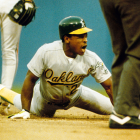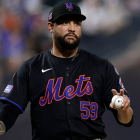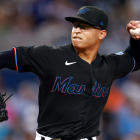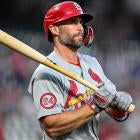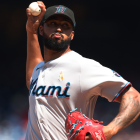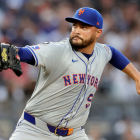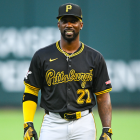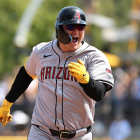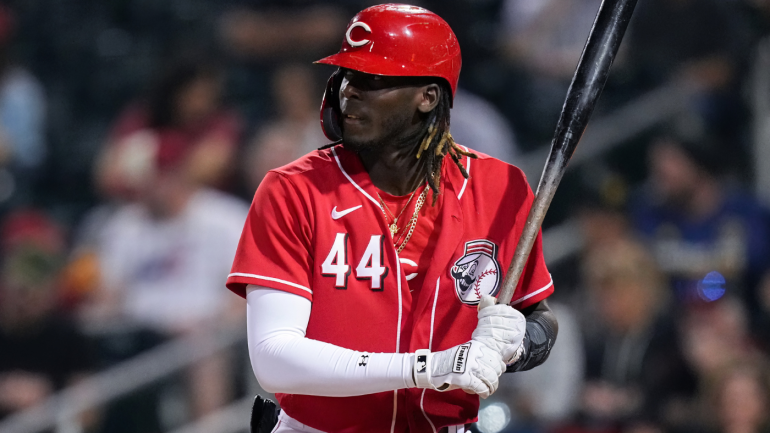
The most exciting prospect in baseball right now is on his way to the major leagues. Elly De La Cruz, a 21-year-old shortstop in the Cincinnati Reds system, is being called up after a scorching-hot start to his season at Triple-A Louisville.
De La Cruz hit .298/.398/.633 with 12 home runs and 11 stolen bases in 38 Triple-A games before his promotion. If he were to somehow maintain that pace over 150 contests, he would finish with a 43-43 season. For those wondering, no player in the history of Major League Baseball has ever accomplished that feat. How's that for a testament to the dynamic, explosive nature of De La Cruz's game.
Oh, and did we mention that he's a switch-hitter? Or that he's listed at 6-foot-5?
Elly De La Cruz is the living embodiment of the guy you made 99 overall on MLB The Show. A literal cheat code 😶@ellylacocoa18 pic.twitter.com/yKqadzW6HI
— Louisville Bats (@LouisvilleBats) June 3, 2023
Add it all together, and De La Cruz is about as intriguing as a prospect can be at this point. Indeed CBS Sports listed De La Cruz at the No. 2 spot in our updated MLB prospect rankings, trailing only Baltimore Orioles shortstop Jackson Holliday. (Holliday, the No. 1 pick in last year's draft, has hit .358/.483/.606 across two levels as a 19-year-old.)
If you aren't already familiar with De La Cruz, it's time to make amends and get to know more about him. We're here to help. Below we've touched on three things worth knowing about his game and his future.
1. Hits the ball extremely hard
The rise of ball-tracking data means the easiest way for a young hitter to improve their standing internally is to show an aptitude for impacting the ball. Exit velocity isn't the end-all, be-all, but never in the history of the game has crushing the ball been considered a bad thing. Besides, a batter who hits the ball hard often likely possesses a combination of desirable traits, including bat speed, strength, and barrel awareness.
De La Cruz, it's fair to write, hits the ball hard. Take a look:
Alllll the angles of Elly De La Cruz's walk-off homer‼️@ellylacocoa18 ╳ @LouisvilleBats pic.twitter.com/7862XPpmIj
— Cincinnati Reds (@Reds) May 31, 2023
On the season, De La Cruz ranks second among qualified Triple-A batters in two important categories: average exit velocity and percentage of batted balls with exit velocities exceeding 95 mph. (In both cases, he trails Boston Red Sox infielder Bobby Dalbec.) De La Cruz entered Sunday sporting marks of 93 mph and 53.8% in those categories. His average launch angle, meanwhile, was 6.8 degrees.
If you're wondering how that stacks up against big-league hitters, here's a look at the qualified batters this season with single-digit average launch angles and average exit velocities exceeding 93 mph:
| Player | Avg EV | Avg LA | OPS+ |
|---|---|---|---|
Ronald Acuña Jr. | 95.1 mph | 7.6 degrees | 157 |
Yandy Díaz | 94.6 mph | 8.8 degrees | 175 |
93.1 mph | 8.5 degrees | 129 | |
93.1 mph | 5.5 degrees | 157 |
As you can tell from the OPS+ column, that's a great group to be in.
We'll note De La Cruz's average launch angle improves to 11.4 degrees on batted balls hit 95 mph or harder. A slugger like Aaron Judge checks in at 21.4 degrees in that respect, while a slap hitter like Myles Straw is situated at 3.7 degrees. De La Cruz, then, almost splits the difference. When he hits the ball with his greatest authority, it tends to go on a line. That bodes well for his chances of hitting for both average and power.
2. Potential platoon problems
The biggest concern about how De La Cruz's game will port to the majors has revolved around his issues with strikeouts. He's sported a high K rate throughout his minor-league career (even now, he's punching out in 27% of his trips to the plate), but breaking his numbers down to a platoon level reveals that his issues are primarily with southpaws.
De La Cruz has struck out in 29.5% of his plate appearances versus lefties this year, as opposed to 25.8% versus righties. He's still produced against lefties (his OPS is actually higher against them than righties), but we do have some concern about him becoming a nominal switch-hitter in the majors based on his underlying data. Take a look:
| Split | Swing% | Contact% | Chase% |
|---|---|---|---|
LHP | 47.1% | 58.0% | 34.5% |
RHP | 38.5% | 72.1% | 24.5% |
If you looked at De La Cruz's surface-level statistics, you wouldn't have reason for concern. You look at these numbers, however, and our worries are more understandable given that he's whiffing versus lefties at an extreme clip. Only one qualified big-league batter has a contact rate under 60% this season, and that's Los Angeles Dodgers rookie James Outman, at 59.1%. De La Cruz has made his contact versus southpaws count, but we're not sure it'll be a sustainable formula in the majors.
Granted, these numbers come from a relatively small-sample size. Plus De La Cruz is young and talented enough to make the necessary adjustments to improve. It's just something in his game that we believe is worth monitoring once he transitions to the majors.
3. Long-term position unclear
The Reds have amassed the most talented group of infield prospects in the National League. In addition to De La Cruz, they employ Noelvi Marte and Edwin Arroyo (both acquired in the Luis Castillo trade); Christian Encarnacion-Strand (Tyler Mahle trade); and Cam Collier and Sal Stewart (first-round picks last summer).
That's without even referencing the youngsters on the big-league roster, like Spencer Steer or Matt McLain, whose stock is up following an adjustment to his swing, or the veterans who have stuck around, such as former Rookie of the Year Award recipient Jonathan India.
India, for his part, recently told The Athletic's C. Trent Rosecrans about De La Cruz's impending arrival: "It's part of the game. There are always guys behind you, always. If I just play well, it won't matter. That's all I can do, play my best and make the decision tough for them."
Having all those infielders gives the Reds a lot of flexibility in trade and roster-building approaches. It also makes it difficult to forecast who will be playing where. De La Cruz, for instance, has played only shortstop and third base this season, but it's conceivable that the Reds may end up moving him down the defensive spectrum to create space elsewhere, a luxury afforded to them by his offensive upside.
Wherever De La Cruz ends up playing, we can assure you he'll be worth watching.










